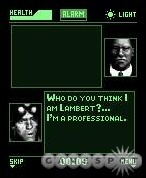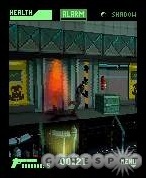The mobile versions of Ubisoft's Splinter Cell series have successfully adapted Sam Fisher's stealth action antics to two dimensions. The resulting games have been less about crouching in the darkness and more about navigating planar space. Tom Clancy's Splinter Cell Pandora Tomorrow 3D's title is slightly misleading, as the game still uses a fixed, scrolling perspective, and again relies on dubious gameplay conceits, such as your enemies' inability to look up. The game's characters, interacting objects, and backgrounds have, however, been rendered in gorgeous, cartoony 3D, and this new paint job makes the game much more visually appealing. While Pandora Tomorrow 3D is hampered by some control problems, surprising brevity, and by its lack of true three dimensionality (a setting in which stealth action games are better served), it's still a technically impressive offering that Sony Ericsson K700i users will want to own.
In Pandora Tomorrow, you command Sam Fisher, gravelly voiced stealth operative extraordinaire. Sam's skills are in such high demand that he's routinely called out of retirement, which makes him even more disagreeable than he might otherwise be. Sam's mission this time around is to infiltrate a base in East Timor, waste some thugs, and leave. There's not a great deal of intrigue here. Admittedly, not much plot is needed to support roughly two hours of gameplay. The short length makes the game rather easy, too, as it seems that just as you're getting the hang of the game's awkward controls, it ends.
Some of the console series' trademark gameplay elements surface in Pandora Tomorrow 3D. Sam can, of course, grab his enemies from behind and judo chop them into unconsciousness. It's again possible to heft snoozing scofflaws over your shoulder, although there's nowhere to cache them in Sam's 2D world. Instead, you'll use their eyes to unlock doors secured by retinal scanners.
In addition to the hapless goons who will periodically turn their backs on Sam to face walls, the middle-aged agent must also contend with alarm-activated gun turrets and readily visible field mines. Some interesting platforming puzzles arise from combinations of these obstacles, which never seem insurmountable. There are often several ways to solve a puzzle, some of which are stealthier than others. For example, you might detonate a field mine with your pistol, thereby killing anyone near it, or you might instead shimmy across the mine-filled chasm and drop onto your foe, knocking him unconscious as you land. Although points are subtracted from your level-completion score for each bullet you fire, there is no real in-game incentive to practice stealth. The ability to play the game several ways nonetheless adds replay value to its slim five levels of action.
As mentioned, Pandora Tomorrow's control is its weakest component. The jump command is bound to the same key that is used to move your character from his crouched position. It's therefore easy to jump when you're just hoping to stand, and you often end up catapulting yourself into a mine in the process. Aiming your gun is even more problematic, and it takes about 15 seconds. You'll have to press the 0 key to turn on your laser sight, and then press the 2 or 8 keys to slowly move the laser to the desired position.

Pandora Tomorrow's sound is almost as impressive as its knockout visuals. Its tunes make full use of the K700i's impressive audio hardware and are stylistically in line with those of the console games--which is to say that they sound like some sort of unholy union between the music of Danny Elfman and that of Kazuki Muraoka.
Pandora Tomorrow 3D has the same fundamental problem faced by its mobile predecessors: You can't sneak around corners if there are no corners to sneak around. That said, the game makes excellent use of its limited perspective and manages to provide enjoyable action within and outside of the stealth mold.
